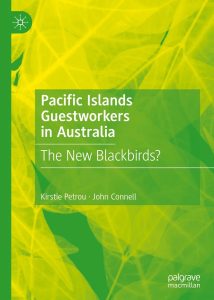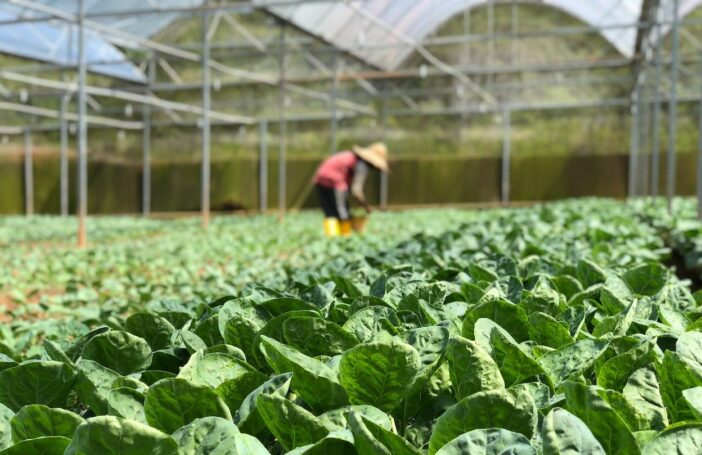 Kirstie Petrou and John Connell’s new book Pacific Islands Guestworkers in Australia: The New Blackbirds? is an important publication. It is the first book on the Seasonal Worker Programme (SWP) – now part of the broader Pacific Australia Labour Mobility or PALM scheme – which, since 2007, has allowed Pacific Islanders to work on Australian farms. It is an interesting read, but a flawed account.
Kirstie Petrou and John Connell’s new book Pacific Islands Guestworkers in Australia: The New Blackbirds? is an important publication. It is the first book on the Seasonal Worker Programme (SWP) – now part of the broader Pacific Australia Labour Mobility or PALM scheme – which, since 2007, has allowed Pacific Islanders to work on Australian farms. It is an interesting read, but a flawed account.
In the first five chapters the book moves through the history of migration from the Pacific to Australia. Chapters 6 to 9 are on seasonal workers’ experiences, often negative, in Australia and on returning home. Chapter 10 is on COVID-19, chapter 11 on the comparison with blackbirding, and chapter 12 concludes.
From chapter 5 onwards, the book has a strong focus on Vanuatu with some reference to other Pacific countries. Timor-Leste receives very little attention, despite its third-place ranking in the number of seasonal workers sent.
Overall, the authors have a positive view of the SWP. They say that it “appears to be a triple win” (p. 416) – good for employers, workers, and their countries. They write that “on balance, the SWP benefits most people most of the time” (p. 413).
Nevertheless, despite this summary positive verdict, the book has quite a negative tone. This is for five reasons.
First, the authors’ style is ambivalent, and they distance themselves from their own positive verdict. The concluding paragraph of the book summarises the SWP not in the positive terms quoted above but as “asymmetrical, ephemeral and occasionally exploitative” (p. 449).
Second, the authors frame the SWP as a cheap source of labour for agricultural employers (p. 104). In fact, SWP workers are paid on casual rates which are 25% above the minimum wage. The range of other costs and obligations incurred by approved employers, such as providing welfare support for the workers, makes an SWP worker an expensive employment option. Research in 2018 showed that non-wage costs per hour were higher for seasonal workers than for backpackers. Many growers still prefer lower cost backpackers, international students, undocumented workers and absconding SWP workers.
Third, the focus in the chapters on SWP workers in Australia is on the problems they have faced. The analysis is too reliant on anecdotes. The reader is presented with a series of snapshots at different times and places, at different stages of evolution of the SWP, and indeed from other seasonal work programs in other countries. It is often a confusing picture that emerges.
For all the material that is presented, Petrou and Connell cannot address the issue of how well or badly Pacific seasonal workers are treated. They offer at the beginning of chapter 7 this disclaimer: “we emphasise the impossibility of quantifying the extent of the issues discussed here; many guestworkers experienced no serious problems during their stay in Australia and most wanted to return again” (p. 188).
Fourth, the two authors dismiss seasonal work as something that doesn’t “contribute significantly to long-term development or … triumph the poor as agents of their own development” (p. 418). This is very odd, especially since the authors admit that “in small island states choices are truncated” and “a poverty of opportunity prevails” (p. 416).
Richard and Charlotte Bedford’s research on New Zealand’s equivalent scheme, the RSE, shows that more than one in every five Samoan and ni-Vanuatu men aged 20-49 years have been an RSE worker at some point since 2007. For Tonga, the ratio is one-third. Any suggestion that this mass movement of people is not the poor acting as agents of their own development (literally, voting with their feet) is bizarre.
We don’t have equivalent figures for Australia’s SWP but the program is now bigger than New Zealand’s RSE. In other research, we have shown that employment on the SWP and RSE combined is now comparable with government employment in Samoa, Tonga and Vanuatu. Yes, remittances have not made any country rich. But if the SWP isn’t a significant contribution to long-term development, we don’t know what is.
Fifth, the authors fail to give a clear answer to their title question. Blackbirding was the mass recruitment of Pacific Islanders to work on plantations in Australia and elsewhere in the late nineteenth century, a practice that, as the authors write, “combined some degree of economic necessity at home and coercion and incentives from recruiters” (p. 47).
At one point, the authors say it is “remarkable … how similar” the SWP is to blackbirding (p. 53). This leads one to think that their answer is yes, SWP workers are the new blackbirds. On the other hand, later in the book, the authors talk about both the “obvious differences” and the “intriguing parallels” (p. 386) between the SWP and blackbirding.
However, they mention only two differences: that “no workers now migrate against their will and contact with home is usually easy enough”. Two other critical differences are not mentioned.
One is all the safeguards embedded into the SWP to prevent exploitation, including that participating employers have to be licensed and agree to numerous conditions, from the provision of regulated accommodation to the delivery of pastoral care; that unions are notified when workers arrive; that Pacific workers have to be paid exactly the same as Australian ones; and so on.
It is this high degree of regulation that explains why research has found that SWP workers fare not worse but better than other horticultural employees. A 2017 report by Adelaide University academics found that “The SWP results in less exploitation of workers.” That report continues: “The design of the SWP means that less incidents of worker exploitation have emerged when compared with other low-skilled visa pathways [e.g., backpackers].”
The other obvious difference between blackbirding and the SWP is that Pacific workers were ingloriously deported from Australia due to the introduction of the White Australia policy and the Pacific Island Labourers Act of 1901. In contrast, the SWP is here to stay. The extent of its growth post-COVID is uncertain and, eventually, demand for farm work may fall victim to automation, but that is only in the very long term. Already Pacific farm workers can stay for up to four years if they can find an employer willing to sponsor them, and the Pacific Engagement Visa will allow those SWP workers lucky enough to win the lottery the right to stay in Australia as permanent residents.
Are SWP workers the new blackbirds? No. Clearly, the “obvious differences” outweigh the “intriguing parallels”. But you won’t find that out by reading Petrou and Connell’s interesting but ultimately obfuscatory book.
The authors respond to the review here.





With regard to the cost of employing SWP workers, I’m not convinced the minimum wage has any meaningful bearing in a context of rural labour scarcity. During COVID, fruit withered on the vine and otherwise unilateral border closures were lifted only to charter in SWP workers – i.e. many employers demonstrably did not have recourse to an alternative supply of labour, let alone a cheaper one. Exceptional circumstances, of course, but I think it stands that SWP workers are relatively cheap within a constrained rural horticultural labour market – only undercut by less productive WHMs or the illegal brokerage of undocumented or irregular workers.
The implied suggestion that employers altruistically bear additional expenses in employing SWP workers brings to mind one of Adam Smith’s more memorable quotes: “It is not from the benevolence of the butcher, the brewer, or the baker that we expect our dinner, but from their regard to their own self-interest. We address ourselves not to their humanity but to their self-love, and never talk to them of our own necessities, but of their advantages”.
Hi Matt,
When you say SWP workers are relatively cheap, relative to what? Relative to other types of horticultural labour they are relatively expensive. That is what the data shows. I’m not sure how you read an implied suggestion that employers are paying more out of altruism. Clearly, those who employ seasonal workers are trading-off their higher costs for their greater reliability and productivity.
Hi Stephen,
Cheap relative to the counterfactual of employing locally-available labour in rural Australia – I’m just not convinced that itinerant WHMs or illegal labour practices are great barometers against which to measure the relative costliness of SWP workers.
I apologise if I misconstrued your point about employer preferences for higher-waged SWP workers as a suggestion of benevolent motives (though it is a sentiment that’s been prevalent in farming groups’ responses to e.g. recent PALM reforms). One does nonetheless wonder why some employers do opt for SWP workers if, as you mention in your review, others prefer lower-waged options: I suspect that the answer relates to SWP workers being the cheapest option (per unit of output) for those employers. Are the ‘productivity’ and ‘reliability’ you mention not relevant factors in costing the relative expense of labour?
Until COVID, farmers used many more backpackers than they did Pacific seasonal workers. So a comparison with backpackers is definitely the best way to measure the relative costliness of SWP workers. Of course, during COVID the backpackers went home. But they are back now, so it is still a very relevant comparison.
On your second point, I would say that SWP are the most profitable option for some employers. That is very different to being the cheapest option.
Hi Bal,
I can’t answer all these questions, but the study we cited in the blog provides good evidence that seasonal workers are better treated than backpackers, the most common visa type for farm workers. That study was a few years ago, and the SWP is much more regulated now than it was then. We’ve called for annual surveys of both SWP workers and employers. That hasn’t happened. But Devpol and the World Bank have recently undertaken (with DFAT funding) a survey of 2,085 SWP and PLS workers. The report is still being worked on, but the key findings were presented at the Pacific Update: see here. In most respect, Pacific seasonal workers are positive about their experience: e.g., pay expectations are met, satisfaction with accommodation is high. But there are certainly issues, such as dissatisfaction with deductions. Interestingly, the study finds positive social as well as economic impacts.
Regards, Stephen
Thank you, Stephen. Will look at the report and its key findings. Would appreciate any information on some of the questions raised in regards to the regulatory, monitoring and enforcement aspects. I am not sure if it is covered in the report. Any thoughts on that would be great.
Thanks, Stephen, for linking to our slides on the survey, and foreshadowing the report.
Bal, as we surveyed workers, we can discuss issues like awareness of where to report problems, comfort in doing so, net pay, and so forth, and some of this is covered in the preview we gave at the Pacific Update in the link from Stephen above.
Regarding regulation, monitoring, and enforcement, however, you probably won’t so much get at this from a worker survey and we don’t look at it. To answer your question on who, I’d start with the FWO (and DEWR) website, as I think (but welcome correction) that this is mostly their remit: https://www.fairwork.gov.au/find-help-for/visa-holders-migrants/pacific-australia-labour-mobility-scheme
In the past, I’ve seen helpful blogs and short reports there on audits and case numbers too (re: how regular, whether implemented etc.), including in comparison to similar sectors and against non-visa holders, but couldn’t find it from a quick search just now. Perhaps you have more luck.
Its probably also worth familiarising yourself with the new deed and guidelines, which mark a regime shift of sorts around the matters you seem concerned with: https://www.dewr.gov.au/pacific-australia-labour-mobility-scheme/consultations/pacific-australia-labour-mobility-palm-scheme-approved-employer-deed-and-guidelines
Best,
Ryan
Thanks for the book review. Referring to the statement on “safeguards embedded to prevent exploitation.” Some questions:
(1) which agency does the regulation and enforcement of those safeguards?
(2) how regular are the monitoring happening in the farms across the country, and what methods of monitoring and regulation are being used?
(3) whoever that does the monitoring, do they have country offices accessible to Pacific workers?
(4) what security is provided to whistleblower workers? Is there incentives for reporting malpractices?
(5) are there empirical studies conducted to prove that the safeguards were implemented?
(6) referring to the statement ‘similarly paid as Australians’, is this based on empirical evidence of actual payslips?
It that appears contrary to the payslips sighted from multiple work stations.